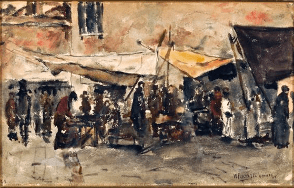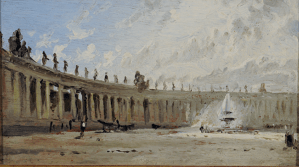Plein Air Painting – Exploring Mediterranea
GRADES 3-6
.
Tennessee State Standards
3.VA.Cn1.A Develop art based on observations of surroundings.
3.VA.R1.B Speculate about processes an artist uses to create a work of art.
4.VA.Cr2.C Document, describe, and represent community spaces and environments.
5.VA.Cn1.A Create art based on personal experiences, current interests, and surroundings.
6.VA.R1.B Identify and interpret works of art that reveal a variety of world cultures and values.
GOALS
Students will be able to:
- Look at art from the exhibition Mediterranea and consider what influenced the artists who travelled to these places
- Examine why American artists went overseas to the Mediterranean to paint
- Understand the role of painting in the natural world

IMAGE CREDIT: William Clothier Watts (1869-1961), Grazing Sheep, Temple of Luxor, Egypt, c. 1915. Watercolor on paper. 23 x 29 in. The Jean and Graham Devoe Williford Charitable Trust.
BACKGROUND
Plein Air painting is the art of painting outdoors where artists can connect directly with the natural world. Some artists paint this way in their own communities while others paint this way while traveling in order to capture their experiences in other countries. Often the artists would make sketches outdoors and then complete their final paintings in the studio. While this practice has been popular for centuries, it was particularly important for many Impressionist artists such as those featured in the exhibition Mediterranea: American art from the Graham D. Williford Collection.

IMAGE CREDIT: William J Forsyth, Venice
VOCABULARY
Plein Air – Painting that is done outside and captures the natural landscapes, built world, and people observed.
Mediterranean – Areas of the world that surround the Mediterranean Sea, including Northern Africa, Spain, France, Italy, Greece, Turkey, and Syria (see map below).
Impressionism – An art movement focused on capturing light and everyday moments with fast, visible brush strokes.
Grand Tour – As part of their formal education, often before marriage, some wealthy European and American men in the late 17th through early 20th centuries traveled internationally. The most popular destinations were the best-known towns and cities or the Renaissance, along with the remains of ancient Roman and Greek civilizations, many of which are found in the Mediterranean region.
Horizon Line – A phrase in art referring to the point where the sky meets the earth or objects connected to the earth, such as buildings, mountains, or other natural/man-made things.

The Mediterranean Sea and its surrounding countries (the Mediterranean region)
DISCUSSION QUESTIONS
-
Why did American and other artists travel to Europe, particularly the Mediterranean region, to paint?
-
How did the works these artists made influence people in the United States and their travel patterns?
-
What landmarks and subject matter did the artists in the exhibition Mediterranea focus on?
-
If you were documenting the place where you live, what would you focus on? How might that be the same or different if you were traveling and visiting someplace new?

ACTIVITY
Make a plein air painting in an outdoor space where you can observe the environment you are in and capture it on canvas. This can be done during class time on the school campus or even in/around the school, or a preliminary sketch can be done at home/outside school and brought back to be finished in class.
1. Find a space (either outside in nature or looking out a window) where students can sit for a minimum of 30 minutes, focused and connected. While there, they will be observing and drawing what they see.
2. Have students use a pencil to quickly sketch in the major compositional elements of their paintings—the horizon line, large objects, any architectural elements, and large natural formations. These should not be detailed sketches but lines and shapes to create an outline of how everything fits together.
3. Younger students should be encouraged to trace their composition with permanent marker to capture more concrete shapes, lines, and contours before painting.
4. Have students choose lighter colors (mixed with white) for the areas where there is more light. Students should paint in the highlights of the composition first—focusing on where the light is shining and the colors they see in those highlighted areas. Remind them to wipe and wash their brushes completely between colors so the colors don’t get muddy.
5. Now students can choose darker colors to paint in the shadows. They can add pops of color where they see them and allow their brush strokes to be loose, in the Impressionist style.
6. Use several sessions in the same space, if possible, to see how perception of the space changes and to encourage looser, more relaxed and confident painting (rather than feeling like every brush stroke needs to be perfect! Artists often revisit the same spaces over and over again, learning new things with continued looking!)
7. Display and share completed work. Take photos to share. Discuss individual experiences and observations in the spaces while painting.
8. Tag #huntermuseum if sharing on social media!
- Pre-cut watercolor paper (5x7)
- Pencils
- Permanent fine tip markers or pens (various colors if available)
- Watercolor paint
- Brushes


